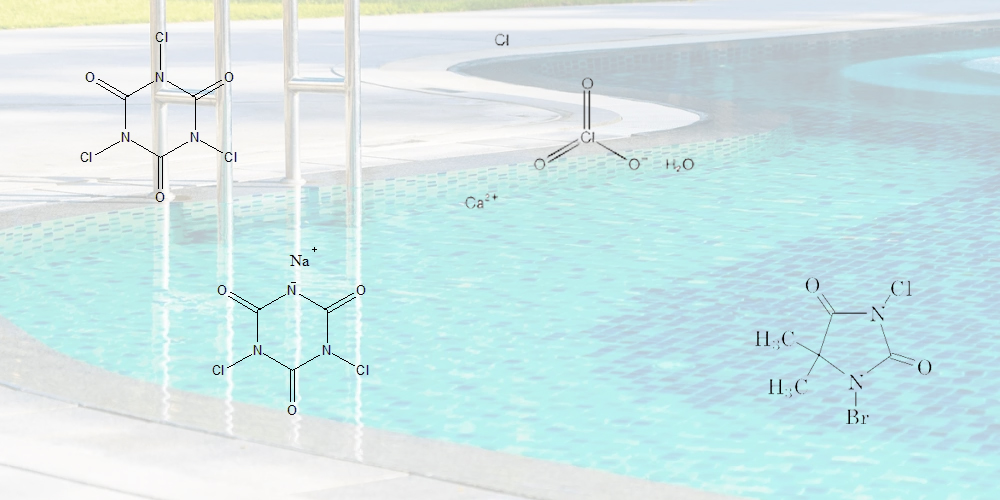İnsanların sağlamlıq və həyat keyfiyyətinə olan tələblərinin yaxşılaşması ilə üzgüçülük populyar idman növünə çevrilmişdir. Bununla belə, hovuzun suyunun keyfiyyətinin təhlükəsizliyi birbaşa istifadəçilərin sağlamlığı ilə bağlıdırhovuzun dezinfeksiyasıgöz ardı edilə bilməyən mühüm əlaqədir. Bu məqalə oxuculara uyğun məhsulları daha yaxşı seçmək və istifadə etmək üçün hovuz dezinfeksiyaedicilərinin əsas təsnifatını və onların optimal tətbiqi ssenarilərini təqdim edəcəkdir.
Hovuz dezinfeksiyaedicilərinin əsas təsnifatı
Hovuz dezinfeksiyaediciləri əsasən aşağıdakı kateqoriyalara bölünür:
1. Xlor əsaslı dezinfeksiyaedicilər
Xlor əsaslı dezinfeksiyaedici maddələr hazırda ən çox istifadə edilən hovuz dezinfeksiya məhsullarıdır, bunlara əsasən aşağıdakılar daxildir:
- Trixloroizosiyanurik turşu(TCCA)
Trixloroizosiyanurik turşu əla bakterisid təsiri və uzun müddət dayanıqlılığı ilə yüksək effektiv və sabit xlor əsaslı dezinfeksiyaedicidir, açıq hovuzlar üçün uyğundur.
- Natrium dikloroizosiyanurat(SDIC)
Bu dezinfeksiyaedici vasitə tez həll olunur və hovuz şoku kimi istifadə edilə bilər. Təcili dezinfeksiya və ya suyun keyfiyyəti aşağı olan hovuzlar kimi sürətli müalicə tələb edən ssenarilər üçün uyğundur.
Kalsium hipoxlorit güclü oksidləşmə qabiliyyətinə malikdir və tez həll olunur. Ancaq təhlükəsiz saxlama və daşınmaya diqqət yetirilməlidir.
2. BCDMH(Bromoxlorodimetilhidantoin)
Bromoklorodimetilhidantoin, hipobrom turşusu və hipoklor turşusu yaratmaq üçün suda həll edilərək davamlı olaraq aktiv Br və aktiv Cl buraxa bilər. Yaranan hipobrom turşusu və hipoklor turşusu güclü oksidləşdirici xüsusiyyətlərə malikdir və sterilizasiya məqsədinə çatmaq üçün mikroorqanizmlərdə bioloji fermentləri oksidləşdirir.
3. Ozon
Ozon mikroorqanizmləri effektiv şəkildə öldürə bilən güclü oksidləşdiricidir və yüksək səviyyəli hovuzlar və spa mərkəzləri üçün uyğundur.
4. Ultraviyole dezinfeksiya
Ultrabənövşəyi texnologiya mikroorqanizmlərin DNT-sini məhv edərək bakteriyaları öldürür, lakin suda qalıq dezinfeksiya qabiliyyətini saxlamaq üçün digər dezinfeksiyaedici maddələrlə birlikdə istifadə edilməlidir.
Müxtəlif ssenarilərdə ən yaxşı dezinfeksiyaedici seçim
Dezinfeksiyaedicinin seçimi hovuzun istifadə ssenarilərindən və şərtlərindən asılı olaraq fərqli olmalıdır.
1. Ailəvi üzgüçülük hovuzu
Ailə hovuzları adətən kiçik ölçülərə malikdir və məhdud istifadə tezliyinə malikdir, ona görə də istifadəsi sadə və saxlanması təhlükəsiz olan dezinfeksiyaedici vasitə seçilməlidir.
-Tövsiyə olunan məhsullar: trixloroizosiyanurik turşu tabletləri və ya natrium dikloroizosiyanurat qranulları.
- Səbəblər:
- Buraxılış miqdarına nəzarət etmək asandır.
- Yaxşı davamlı dezinfeksiya effekti və aşağı texniki xidmət tezliyi.
- Sianur turşusu komponentləri xlorun aktivliyini effektiv şəkildə qoruya bilər.
2. Açıq ictimai hovuzlar
Açıq ictimai hovuzlar tez-tez istifadə olunur və çox sayda insan axınına malikdir, bu da səmərəli və qənaətcil dezinfeksiya həllərini tələb edir.
- Tövsiyə olunan məhsullar:
- Trichloroisocyanuric acid (gündəlik qulluq üçün uyğundur).
- SDIC və (pik dövrlərdə sürətli tənzimləmə üçün uyğundur).
siyanurik turşu ilə kalsium hipoklorit
- Səbəblər:
- Stabil xlor buraxma qabiliyyəti yüksək yük tələblərinə cavab verir.
- Nisbətən aşağı qiymət, geniş miqyaslı tətbiq üçün uyğundur.
3. Bağlı üzgüçülük hovuzları
Bağlı üzgüçülük hovuzlarında məhdud ventilyasiya şəraiti var və xlorun buxarlanması sağlamlıq problemlərinə səbəb ola bilər, ona görə də aşağı dəyişkən və ya uçucu olmayan məhsullar seçilməlidir.
- Tövsiyə olunan məhsullar:
- Kalsium hipoxlorit.
- SDIC
- Xlor olmayan dezinfeksiyaedicilər (PHMB kimi).
- Səbəblər:
- Xlor qoxusunu və qıcıqlanmasını azaldır.
- İstifadəçi təcrübəsini yaxşılaşdırarkən təmizliyi qoruyun.
4. Spa və ya yüksək səviyyəli hovuzlar
Bu yerlər suyun saflığına və istifadəçi təcrübəsinə diqqət yetirir və adətən daha ekoloji cəhətdən təmiz və səmərəli həllər seçirlər.
- Tövsiyə olunan məhsullar: SDIC, BCDMH, ozon
- Səbəblər:
- Kimyəvi qalıqları azaltmaqla yüksək effektiv sterilizasiya.
- İstifadəçinin rahatlığını və etibarını artırın.
5. Uşaq hovuzları
Uşaq üzgüçülük hovuzlarında aşağı qıcıqlanma və təhlükəsizliyə xüsusi diqqət yetirilməlidir.
- Tövsiyə olunan məhsullar: SDIC, PHMB
- Səbəblər:
- Xlorsuz dezinfeksiyaedici maddələr dəri və gözlərdə qıcıqlanmanı azalda bilər.
- Ultrabənövşəyi şüalar zərərli əlavə məhsulların əmələ gəlməsini azaldır.
Hovuzun dezinfeksiyası üçün ehtiyat tədbirləri
Dezinfeksiyaediciləri seçərkən və istifadə edərkən aşağıdakı məqamlara da diqqət yetirməlisiniz.
1. Məhsul təlimatlarına əməl edin
Müxtəlif dezinfeksiyaedicilərin dozası və istifadə üsulları fərqlidir. Doza həddindən artıq və ya az dozanın qarşısını almaq üçün təlimatları ciddi şəkildə yerinə yetirməlisiniz.
2. Suyun keyfiyyətinə mütəmadi olaraq nəzarət edin
Suyun keyfiyyətinin standartlara cavab verdiyinə əmin olmaq üçün suda pH dəyərini, qalıq xlor konsentrasiyasını və ümumi qələviliyi müntəzəm olaraq yoxlamaq üçün hovuz test zolaqlarından və ya peşəkar sınaq avadanlığından istifadə edin.
3. Kimyəvi maddələrin qarışmasının qarşısını alın
Müxtəlif növ dezinfeksiyaedici maddələr kimyəvi reaksiya verə bilər, ona görə də istifadə etməzdən əvvəl uyğunluq təsdiqlənməlidir.
4. Təhlükəsiz saxlama
Dezinfeksiyaedici maddələr quru, yaxşı havalandırılan, yüksək temperaturdan və birbaşa günəş işığından uzaq, uşaqların əli çatmayan yerdə saxlanmalıdır.
Hovuz dezinfeksiyaedicilərinin seçilməsi və istifadəsi hovuz suyunun keyfiyyətinin qorunmasının açarıdır. Müxtəlif ssenarilərin ehtiyaclarına uyğun olaraq düzgün dezinfeksiyaedicinin seçilməsi nəinki suyun keyfiyyətinin təhlükəsizliyini effektiv şəkildə təmin edə bilər, həm də texniki xidmət xərclərini azalda və istifadəçi təcrübəsini yaxşılaşdıra bilər. kimihovuz kimyəvi maddələrinin istehsalçısı, bizim çoxillik təcrübəmiz var. Hovuz kimyəviləri haqqında əlavə məlumat və ya xidmət dəstəyinə ehtiyacınız varsa, lütfən bizimlə əlaqə saxlayın.
Göndərmə vaxtı: 16 dekabr 2024-cü il


